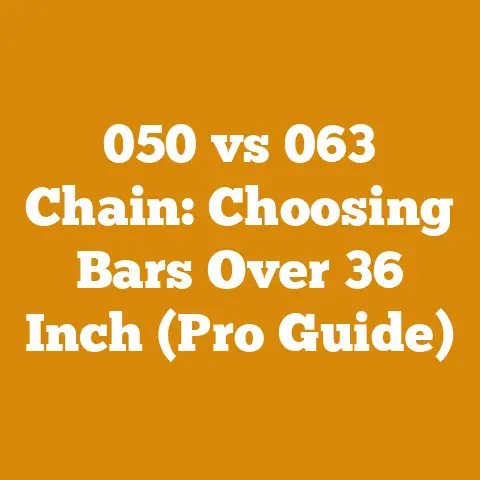Stump Grinding with a Chainsaw (5 Expert Tips for Clean Cuts)
As a seasoned woodcutter, I’ve spent countless hours wrestling with stubborn tree stumps. I still remember the first time I tried to grind a stump with a chainsaw – a complete disaster! The chain kept binding, the wood chipped unevenly, and I ended up with a dull chain and a very frustrated attitude. Over the years, I’ve learned a few tricks that make stump grinding with a chainsaw much easier, safer, and more effective. These aren’t just theoretical tips; they’re based on real-world experience, trial and error, and a healthy respect for the power of a chainsaw.
Stump Grinding with a Chainsaw: 5 Expert Tips for Clean Cuts
Grinding a stump with a chainsaw is a task that demands precision, patience, and a solid understanding of chainsaw safety. While specialized stump grinders are ideal, a chainsaw can be a viable option for smaller stumps or when access is limited. These five expert tips will guide you through the process, helping you achieve clean cuts and minimize the risks involved.
1. Chainsaw Selection and Preparation
Choosing the right chainsaw and preparing it properly is the first crucial step. Not all chainsaws are created equal, and using the wrong one for stump grinding can lead to damage, inefficiency, and potential injury.
Selecting the Right Chainsaw
- Power and Engine Size: For stump grinding, I recommend a chainsaw with a minimum engine size of 50cc. Anything smaller, and you’ll struggle to cut through dense wood, especially hardwood stumps. A larger engine (60cc or more) will make the job significantly easier and faster. I personally use a Stihl MS 362 C-M (59.8cc) for most stump grinding tasks. It offers a good balance of power and maneuverability.
- Bar Length: The bar length should be appropriate for the diameter of the stump you’re tackling. A bar that’s too short will limit your reach, while one that’s too long can be unwieldy and increase the risk of kickback. I find a 18-20 inch bar to be a good all-around choice for most residential stumps.
- Chain Type: Use a chain specifically designed for dirty or abrasive conditions. These chains have hardened cutters that resist dulling when exposed to dirt and grit often found around tree stumps. A carbide-tipped chain is an excellent option for particularly stubborn stumps.
- Weight and Balance: Consider the weight and balance of the chainsaw. Stump grinding can be physically demanding, so choose a chainsaw that you can comfortably handle for extended periods. A well-balanced chainsaw will reduce fatigue and improve control.
Preparing Your Chainsaw
- Sharpen the Chain: A sharp chain is essential for efficient and safe stump grinding. A dull chain will require more force, increasing the risk of kickback and putting unnecessary strain on the chainsaw. Sharpen the chain before each grinding session, and consider touching it up periodically as needed. I use a chainsaw chain sharpener with a 30-degree angle for most chains.
- Check Chain Tension: Ensure the chain is properly tensioned. A loose chain can derail, while an overly tight chain can cause excessive wear and tear on the bar and sprocket. Refer to your chainsaw’s manual for the correct tensioning procedure.
- Lubricate the Chain: Keep the chain well-lubricated with bar and chain oil. This will reduce friction, prolong the life of the chain and bar, and improve cutting performance. Check the oil level frequently during grinding and refill as needed. I prefer using a biodegradable bar and chain oil to minimize environmental impact.
- Inspect the Chainsaw: Before starting, thoroughly inspect the chainsaw for any signs of damage or wear. Check the spark plug, air filter, and fuel lines. Make sure the safety features, such as the chain brake and throttle lock, are functioning correctly.
Takeaway: Selecting the right chainsaw and ensuring it’s properly prepared are crucial for safe and efficient stump grinding. A powerful chainsaw with a sharp, well-lubricated chain will make the job much easier and reduce the risk of accidents.
2. Safety First: Essential Protective Gear and Precautions
Safety should always be your top priority when working with a chainsaw. Stump grinding is a particularly hazardous task due to the proximity to the ground, the potential for kickback, and the presence of dirt and debris.
Essential Protective Gear
- Eye Protection: Wear safety glasses or a face shield to protect your eyes from flying wood chips and debris. I prefer a full-face shield for maximum protection.
- Hearing Protection: Chainsaws are incredibly loud, so wear earplugs or earmuffs to prevent hearing damage. I recommend earmuffs with a noise reduction rating (NRR) of at least 25 dB.
- Head Protection: A hard hat is essential to protect your head from falling branches or other debris.
- Hand Protection: Wear heavy-duty work gloves to protect your hands from cuts, abrasions, and vibrations. Look for gloves with reinforced palms and fingers.
- Leg Protection: Chainsaw chaps are crucial for protecting your legs from accidental cuts. They are made of multiple layers of ballistic nylon that will jam the chainsaw if it comes into contact with them.
- Foot Protection: Wear steel-toed boots to protect your feet from falling objects and chainsaw cuts.
Safety Precautions
- Clear the Area: Before starting, clear the area around the stump of any obstacles, such as rocks, roots, or debris. This will prevent tripping hazards and reduce the risk of damaging the chainsaw.
- Inspect the Stump: Carefully inspect the stump for any hidden objects, such as nails, wires, or rocks. These objects can damage the chainsaw and cause it to kick back.
- Maintain a Safe Distance: Keep bystanders and pets at a safe distance from the work area.
- Proper Stance: Maintain a stable stance with your feet shoulder-width apart. Keep your weight balanced and avoid overreaching.
- Avoid Kickback Zone: Be aware of the chainsaw’s kickback zone, which is the upper quadrant of the bar tip. Avoid using this area of the bar when grinding a stump.
- Work in Good Lighting: Ensure you have adequate lighting to see what you’re doing. Avoid grinding stumps in low-light conditions.
- Take Breaks: Stump grinding can be physically demanding, so take frequent breaks to avoid fatigue.
- Never Work Alone: It’s always a good idea to have someone nearby in case of an emergency.
- First Aid Kit: Keep a well-stocked first aid kit readily available.
Takeaway: Prioritizing safety is paramount when grinding stumps with a chainsaw. Wearing appropriate protective gear and following safety precautions can significantly reduce the risk of injury.
3. Mastering the Grinding Technique
The key to achieving clean cuts and minimizing kickback is to use the correct grinding technique. This involves a combination of controlled movements, proper angles, and a good understanding of how the chainsaw interacts with the wood.
Initial Assessment
- Determine the Stump’s Size and Shape: Before you start cutting, take a moment to assess the size and shape of the stump. This will help you determine the best approach for grinding it down.
- Identify Potential Obstacles: Look for any potential obstacles, such as rocks, roots, or buried objects.
- Plan Your Cuts: Plan your cuts in advance to ensure you remove the stump efficiently and safely.
Step-by-Step Grinding Process
- Start at the Top: Begin by grinding down the top of the stump, working in a circular motion. Use the bottom of the chainsaw bar to make controlled cuts, removing small amounts of wood at a time.
- Work in Layers: Grind the stump down in layers, removing a few inches of wood with each pass. This will prevent the chainsaw from binding and make the job easier.
- Angle the Chainsaw: Angle the chainsaw slightly downward to help direct the wood chips away from you.
- Use a Sweeping Motion: Use a sweeping motion to move the chainsaw across the stump, ensuring you remove wood evenly.
- Avoid Plunging Cuts: Avoid making plunging cuts into the stump, as this can increase the risk of kickback.
- Grind the Sides: Once you’ve ground down the top of the stump, start working on the sides. Use the same technique, working in layers and angling the chainsaw downward.
- Remove the Roots: As you grind down the sides of the stump, you’ll encounter the roots. Carefully grind away the roots, taking care not to damage the chainsaw on rocks or other debris.
- Final Smoothing: Once you’ve removed the bulk of the stump, use the chainsaw to smooth out the remaining wood. This will create a clean, even surface.
Tips for Clean Cuts
- Keep the Chainsaw Moving: Keep the chainsaw moving at a consistent speed to prevent it from binding.
- Avoid Overheating: Avoid overheating the chainsaw by taking breaks and allowing it to cool down.
- Use a Guide: Consider using a guide, such as a piece of wood or metal, to help you make straight cuts.
- Sharpen the Chain Frequently: A sharp chain is essential for clean cuts. Sharpen the chain frequently, especially when grinding stumps that are dirty or abrasive.
Takeaway: Mastering the grinding technique is essential for achieving clean cuts and minimizing the risk of kickback. By working in layers, using controlled movements, and maintaining a sharp chain, you can effectively grind down stumps with a chainsaw.
4. Dealing with Common Challenges
Stump grinding isn’t always a straightforward process. You’ll likely encounter various challenges along the way, such as hidden rocks, tough wood, and difficult angles. Knowing how to deal with these challenges will help you complete the job safely and efficiently.
Hidden Rocks and Debris
- Thorough Inspection: Before you start grinding, thoroughly inspect the stump area for any signs of rocks, metal, or other debris. Use a metal detector if necessary.
- Gentle Approach: If you suspect there may be hidden objects, start grinding gently and listen for any unusual sounds.
- Stop Immediately: If you hit a rock or other object, stop grinding immediately and inspect the chainsaw for damage.
- Remove the Obstacle: If possible, remove the obstacle before continuing to grind.
Tough Wood
- Sharp Chain: Ensure your chain is razor-sharp. A dull chain will struggle to cut through tough wood.
- Apply Pressure Gradually: Apply pressure to the chainsaw gradually, allowing it to cut through the wood at its own pace.
- Avoid Forcing the Chainsaw: Avoid forcing the chainsaw, as this can cause it to bind or kick back.
- Use a Larger Chainsaw: If you’re consistently struggling to cut through the wood, consider using a larger chainsaw with more power.
Difficult Angles
- Adjust Your Stance: Adjust your stance to maintain a stable and balanced position.
- Use a Shorter Bar: A shorter bar will be easier to maneuver in tight spaces.
- Work in Small Sections: Grind the stump in small sections, focusing on one area at a time.
- Consider an Alternative Tool: If you’re struggling to reach a particular area with the chainsaw, consider using an alternative tool, such as an axe or a mattock.
Chainsaw Binding
- Stop Immediately: If the chainsaw binds, stop immediately and turn it off.
- Inspect the Cut: Inspect the cut to see what’s causing the binding.
- Remove the Chainsaw: Carefully remove the chainsaw from the cut.
- Adjust Your Technique: Adjust your technique to prevent the chainsaw from binding again. This may involve reducing the amount of wood you’re removing with each pass or changing the angle of the cut.
Takeaway: Stump grinding can present various challenges, but with the right approach and techniques, you can overcome them safely and efficiently. Remember to inspect the area, use a sharp chain, and adjust your technique as needed.
5. Stump Removal Alternatives and Considerations
While grinding a stump with a chainsaw can be effective, it’s not always the best solution. There are several alternative methods for stump removal, each with its own advantages and disadvantages.
Stump Grinder Rental
- Professional Results: Renting a dedicated stump grinder is the most efficient and effective way to remove a stump. Stump grinders are designed specifically for this purpose, and they can quickly and easily grind down even large stumps.
- Cost: Renting a stump grinder can be expensive, but it’s often worth the cost if you have several stumps to remove. Rental costs typically range from $100 to $300 per day.
- Ease of Use: Stump grinders can be challenging to operate, so it’s essential to read the instructions carefully and follow all safety precautions.
- Availability: Stump grinders are available for rent at most equipment rental stores.
Chemical Stump Removal
- Slow Process: Chemical stump removal involves using chemicals to accelerate the decomposition of the stump. This is a slow process that can take several months or even years to complete.
- Environmental Concerns: The chemicals used for stump removal can be harmful to the environment, so it’s essential to use them carefully and follow all instructions.
- Cost-Effective: Chemical stump removal is relatively inexpensive, but it requires patience.
- Effectiveness: The effectiveness of chemical stump removal can vary depending on the type of wood and the environmental conditions.
Manual Removal
- Labor-Intensive: Manual stump removal involves digging around the stump and cutting away the roots with an axe, saw, or mattock. This is a labor-intensive process that can be difficult and time-consuming.
- Suitable for Small Stumps: Manual stump removal is best suited for small stumps that are not too deeply rooted.
- Cost-Effective: Manual stump removal is relatively inexpensive, but it requires a lot of physical effort.
- Environmental Impact: Manual stump removal has a minimal environmental impact.
Burning
- Regulations: Burning stumps is subject to local regulations and may not be permitted in all areas.
- Safety Hazards: Burning stumps can be dangerous and can create a fire hazard.
- Environmental Impact: Burning stumps can release harmful pollutants into the air.
- Time-Consuming: Burning stumps can take several days or even weeks to complete.
Considerations
- Stump Size: The size of the stump will influence the best removal method.
- Root System: The extent of the root system will also affect the removal process.
- Location: The location of the stump may limit your options.
- Environmental Concerns: Consider the environmental impact of each removal method.
- Cost: Factor in the cost of each removal method, including equipment rental, materials, and labor.
- Time: Consider the amount of time required for each removal method.
Takeaway: Stump grinding with a chainsaw is just one option for stump removal. Consider the alternatives and choose the method that best suits your needs and circumstances. Always prioritize safety and follow all applicable regulations.
By following these five expert tips, you can safely and effectively grind stumps with a chainsaw. Remember to choose the right chainsaw, prioritize safety, master the grinding technique, deal with common challenges, and consider alternative removal methods. With patience and practice, you’ll be able to tackle even the most stubborn stumps. I hope my experiences and insights help you in your stump grinding endeavors!






